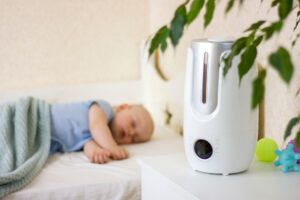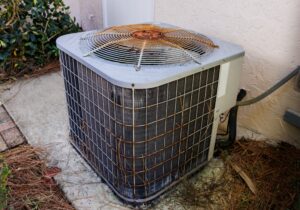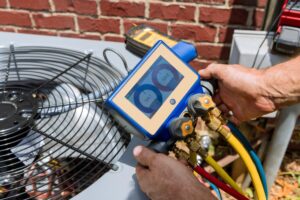For many people, winter means dry hands, cracked lips, and irritated noses. That discomfort is because cold air holds far less moisture than warm air, leaving our surroundings — and our skin — parched. While combating this dryness is a priority, it’s important to remember that both too much and too little humidity in your home can lead to problems. During the winter months, it’s important to find the right balance for protecting your comfort, health, and even your home’s condition. Keep reading to find out what the ideal humidity level is for homes in winter and how you can create a more comfortable living space.
The Ideal Indoor Humidity Range During Winter
Experts recommend keeping your home’s humidity level between 30% and 50% during the colder months. However, staying on the lower end of this range — between 30% and 40% — is often better when temperatures drop significantly.
Why this range? Humidity levels below 30% can dry out your skin and respiratory system, exacerbate allergies, and cause wooden furniture, floors, and even musical instruments to crack. On the other hand, levels above 50% can lead to condensation on windows and create a breeding ground for mold and mildew throughout the house.
In Burlington, WI, where winter temperatures can drop to freezing or below, finding this balance becomes even more critical. Local homes often rely on heating systems to stay warm, but these systems can drastically reduce indoor humidity levels, making it essential to monitor and adjust humidity as needed.
How Outdoor Temperatures Affect Indoor Humidity
Your home humidity level during winter isn’t static — it changes based on the outdoor temperature. As temperatures drop, it’s necessary to lower your indoor humidity to avoid problems like condensation forming on windows or even frost building up inside your home.
Here’s a quick guide to help you find the appropriate indoor humidity level based on outdoor temperatures:
- Above 50°F: Aim for 40%-50% indoor humidity.
- Between 20°F and 50°F: Lower the humidity to around 35%-40%.
- Between 0°F and 20°F: Keep humidity levels between 30%-35%.
- Below 0°F: Reduce the humidity further to around 25%-30%.
By following these recommendations, you can prevent excess moisture from damaging your home while avoiding the discomfort of dry indoor air. For residents in Burlington, WI, winter often brings a mix of these temperatures, so being flexible with your humidity settings is key.
Why Maintaining Ideal Humidity Is Important
Homeowners across Burlington, WI, choose to invest in balancing their homes’ relative humidity levels not just because it improves comfort but because it also benefits their health, their home, and even their energy bills:
- For Your Health: Proper humidity levels prevent dry skin, reduce the risk of respiratory infections, and alleviate symptoms of allergies and asthma.
- For Your Home: Balanced humidity protects wood floors, furniture, and doors from cracking or warping and prevents condensation that could lead to mold growth.
- For Energy Efficiency: Proper moisture levels make your home feel warmer, allowing you to lower your thermostat and save on energy costs.
Signs Your Home’s Humidity Needs Attention This Winter
These signs say it’s time to get a humidifier:
- You’re dealing with a lot of static electricity.
- You and your family are suffering from dry, itchy skin.
- You have cracked wooden furniture.
- You’ve noticed gaps in your wood floors.
- Your family has had frequent sore throats.
- You have experienced increased allergy symptoms.
How to Improve Your Home’s Indoor Humidity Levels
If your home feels too dry during winter, don’t worry — there are plenty of ways to boost its humidity and make your space more comfortable. Here are some practical tips to help you maintain the ideal indoor humidity during winter:
Invest in a Humidifier
Humidifiers are one of the most effective tools for improving indoor humidity levels. Whole-home humidifiers, in particular, work with your HVAC system to distribute moisture evenly throughout your home and provide consistent comfort in every room. Portable units are suitable for boosting humidity in specific rooms that need a little more attention, like the bedroom.
Seal Air Leaks
Prevent cold, dry air from seeping into your home by sealing gaps around windows and doors. Weatherstripping and caulking are simple solutions that help maintain humidity while improving energy efficiency.
Use Houseplants
Certain plants, like peace lilies and spider plants, naturally release moisture into the air through a process called transpiration. Plus, adding greenery to your home can also improve indoor air quality by removing contaminants.
Boil Water
Boiling water on your stove is a quick and easy way to add moisture to the air. Consider simmering a pot of water with cinnamon sticks or citrus peels for a cozy, fragrant boost.
Dry Laundry Indoors
Skip the dryer and hang damp clothes on drying racks to boost your home’s humidity level during winter. As the water evaporates from the fabric, it will return to the air in the room.
Achieve the Perfect Indoor Humidity for Winter Comfort
If you’re experiencing any issues related to low humidity in your home, don’t wait for the problem to worsen. The experts at H.J. Faust are here to help you achieve and maintain the ideal indoor humidity level during the winter months. We can assess your specific situation, recommend appropriate solutions, and install the best whole-house humidifier for your needs.
Contact our team today to request a quote on a whole-home humidifier installation!



